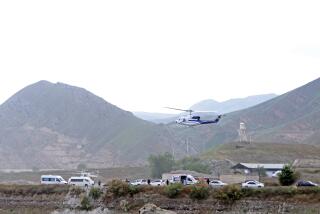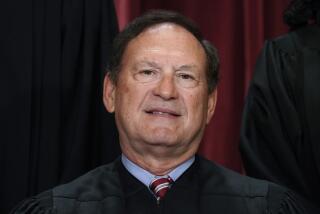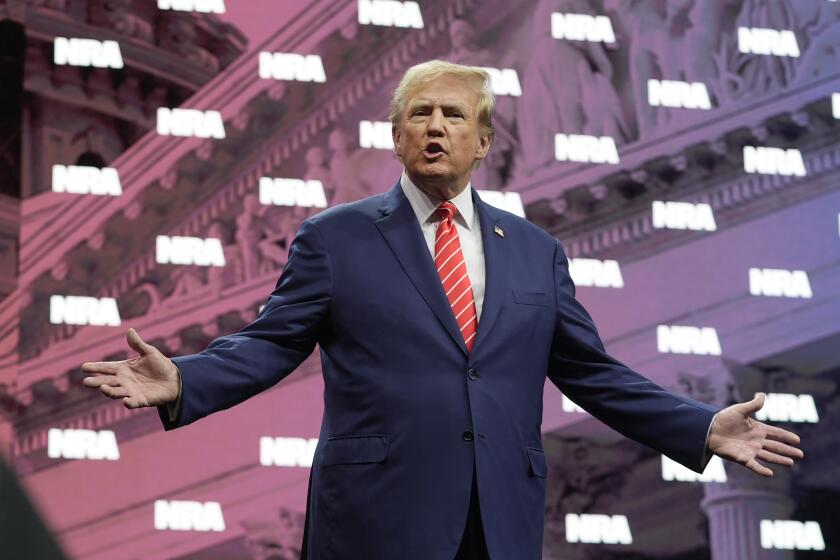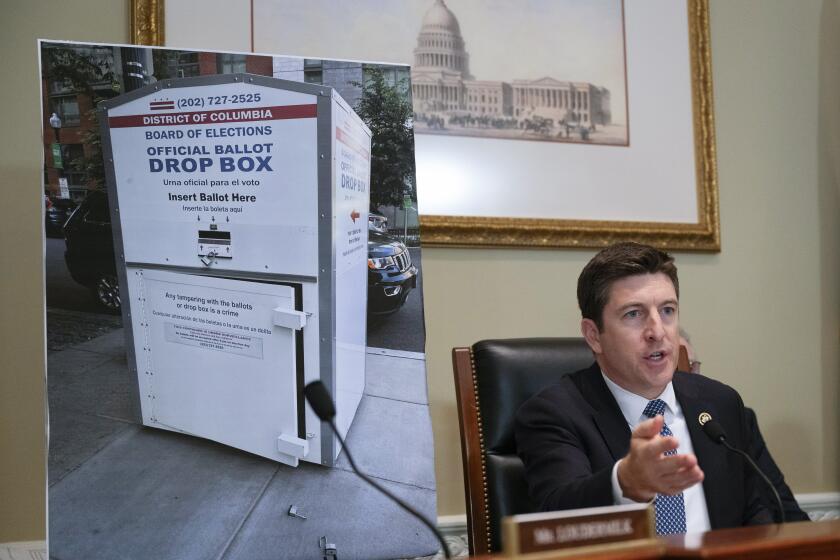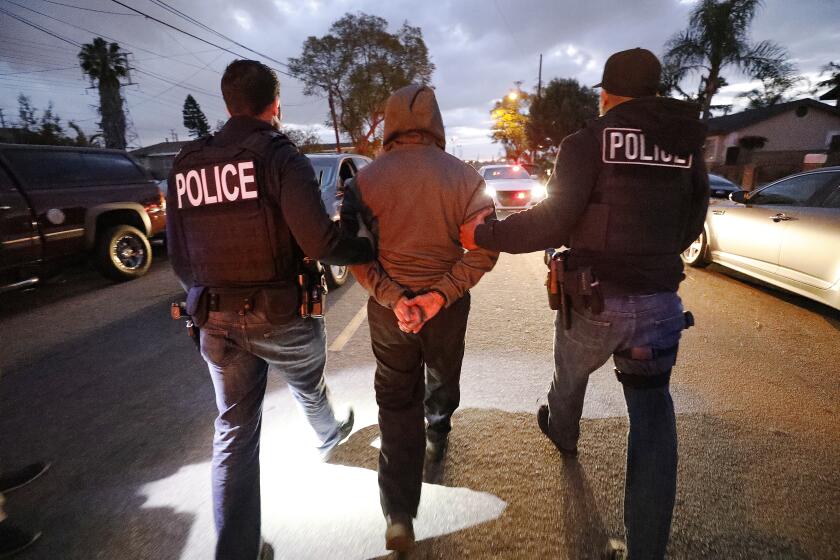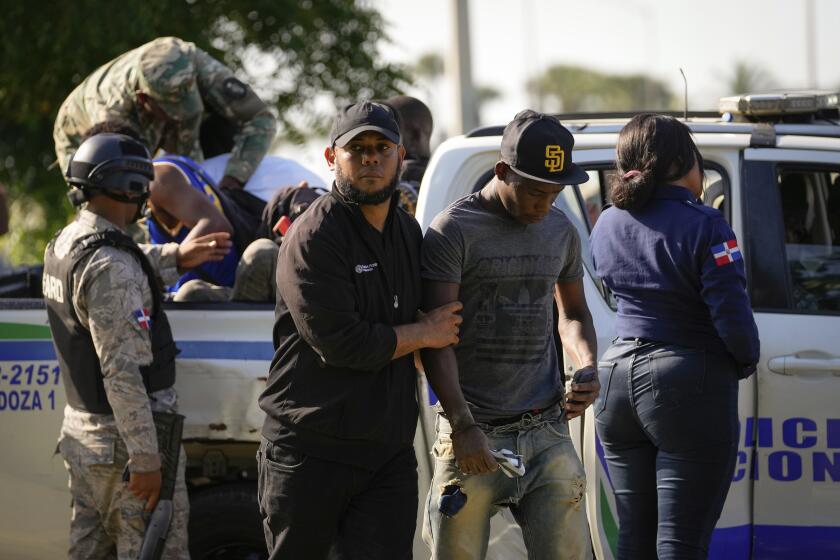A Drop in the Bucket : There is a Chronic Need for Latino Blood Donors, but Red Cross Efforts to Get More Volunteers to Roll Up Their Sleeves Have Had Limited Success
The goal for the 5 1/2-hour blood drive in East Los Angeles was to collect at least 35 pints from donors, preferably Latinos.
Everything seemed in order. The appointment sheet listed 60 names. The American Red Cross staff and volunteers were ready and waiting in their baby-blue medical gowns. The packaged sterile equipment was set up for easy access.
But the results were a disappointment: just 20 pints of blood.
Once again the no-shows far outnumbered those who followed through with their roughly one-hour session: registering, answering a few health-related questions, undergoing a quick blood test, donating a pint, and then relaxing for several minutes with some cookies and fruit juice.
“It’s disappointing because we were sitting around doing nothing,” said Kathy Mealins, a registered nurse in charge of the blood drive earlier this month at a Red Cross center on 3rd Street. “We could have done 40 pints if more people had come in.”
For several months, at least since American Red Cross President Elizabeth Dole spoke out in March about the chronic need for Latino blood donors in the Los Angeles area, local organizers have been trying to find ways to persuade more Latinos to roll up their sleeves.
Appeals were made at churches. Schools with large Latino enrollments were pushed to encourage donors. Blood drives were sponsored by Spanish-language radio stations. Even a “job fiesta” was held to promote full and part-time positions with the Red Cross.
So far, officials said, the results have been limited--often falling short of goals--though the need for blood donors of all ethnic backgrounds is virtually constant. The shortage can be crucial during the summer, when potential donors go on vacation, they said.
The Latino community, more than any other, is being called upon to play a key role in keeping the local blood supply healthy.
Essentially, officials said, a large percentage of Latinos have Group O blood, which is frequently used to treat patients in emergencies when there is little time to identify the victim’s own blood type. About 60% to 70% of Latinos, compared with less than half of the general population, have this type of blood, officials said.
The problem is that although 34% of the population in Los Angeles and Orange counties is Latino, only about 15% of those who donate blood through the Red Cross identify themselves as Latino.
To make matters worse, during the last year only about 160,000 people out of 13 million in the two counties donated blood to the Red Cross. Only about half of those who sign up to give blood actually show up for their appointments.
Officials, including Dole, who is the wife of presidential hopeful Sen. Robert Dole (R-Kansas), acknowledged that the agency has not done well over the years at communicating with the Latino community. Its recent attempts include hiring more Latino nurses and field workers or others who can speak Spanish, officials said.
The campaign must also cope with dispelling concerns that potential Latino donors may have about giving blood.
Patricia Salas, 34, a walk-in donor at the East Los Angeles center, said too many Latinos believe various myths about giving blood. Many fear they can be infected with the AIDS virus, some think donating blood causes weight gain, others believe they will be unable to work for extended periods because their strength will be sapped, and some are just plain afraid of needles or pain, she said.
“It’s very sad because there aren’t many giving blood very often,” said Salas, a project coordinator for the Multicultural Area Health Education Center, a nonprofit agency in the same building as the Red Cross center.
Salas, who was a nurse in Peru and plans to become certified in California, said she gives blood regularly, usually at a hospital rather than a Red Cross site.
On this day, Salas, of Covina, was recruited by a Red Cross worker who was eager to find donors during a particularly slow period. It was about an hour into the drive and only three donors--none Latino--had come and gone.
The six Red Cross staff members and two volunteers--some reading, some chatting--sat scattered throughout the donor room. Empty were the two cubicles for donor interviews, the three cots for drawing blood and the chairs at the canteen, where packets of cookies and cartons of juice were lined up neatly.
“There isn’t good information,” Salas said in Spanish as she completed her registration form. “The publicity is only recent.”
In publicizing blood drives, Red Cross and community representatives assure residents that there is no possibility of contracting AIDS by donating blood because each needle is sterile when used and then is discarded. Weight gain is not a side effect of giving blood, and most people can resume normal activities 15 minutes after making a donation. There are, however, a few basic physical requirements. Donors must weigh at least 110 pounds, be at least age 17 and in general good health.
Also, officials said, donors need not worry about the Red Cross passing along any information from the registration forms to other agencies of any kind.
One question currently asked on the forms is place of birth--specifically, whether donors were born in Mexico, Central America or South America. Responses will be used strictly for a study on a disease called Chagas, which can result from a parasite found in those regions, officials said.
Sonia Moran, 25, of East Los Angeles, who arrived at the center with her brother-in-law, Junior Garcia, and her nephew, Michael Garcia, was not fazed by any of the requirements.
“I try to give regularly,” said Moran, adding that she knew nothing of the Red Cross push to attract more Latino blood donors. “I think mainly why Latinos wouldn’t come is just the lack of knowledge. Not knowing the good you can do for other people.”
Two of the nurses drawing blood from donors, Eunice Percy-Campbell, a registered nurse, and Pat Daniels, a licensed vocational nurse, said the process is painless for most people, but many are discouraged by rumors about risks and side effects.
“I think a lot of people hear what other people say and the stories get bigger and bigger,” Daniels said with a chuckle.
But the entire Red Cross effort is designed to place Latino residents at ease, said Cheryle Babbitt, managing director of donor services for American Red Cross blood services.
In its efforts to attract Latino donors, Babbitt said the agency has made mistakes, such as translating written information into Spanish but then failing to provide Spanish-speaking staff who could answer questions satisfactorily for potential donors. Many Latinos opted to stay away, she said.
“The realization [of changing demographics] came to us some time ago,” said Babbitt, a 20-year veteran of the Red Cross. “We were not able to adequately address these questions. Those efforts were unsuccessful.”
Babbitt said that so far this year, the number of Spanish-speaking nurses or medical assistants who help donors in the region each day has increased from fewer than 10 to about 40, about one-third of the field staff.
In addition, a coalition of Latino community volunteers is helping by advising Red Cross officials as well as residents, she said.
“We want to include Latinos in what we’re doing,” Babbitt said. “Certainly they are receiving blood and blood transfusions.”
There are some signs that the message may be trickling out to some Latinos, although the results often fall short in actual donations.
A blood drive sponsored by radio stations KTNQ-AM (1020) and KLVE-FM (107.5) at three sites on June 9-10 generated about 125 pints of blood, a welcome total but far less than what organizers hoped for.
At Roosevelt High School in Boyle Heights, a blood drive June 6 impressed organizers when 179 pints of blood were collected.
Louis D. Velasquez, assistant director of the Oficina de Ministerio Hispanos of the Archdiocese of Los Angeles, said local churches have committed themselves to helping the Red Cross efforts.
“It’s a religious act. Jesus died for us and gave up his blood,” Velasquez said, adding that street violence is one unfortunate reason that blood donations are always necessary. “Much of this blood may be used in our own communities.”
The Rev. Gabriel Gonzales, pastor at Sacred Heart Church in Lincoln Heights, said a blood drive is scheduled at the church today.
“I’ve been really happy. We’re hoping this will be the first of many,” he said. “I tell them I have given over a gallon myself.”
Officials said such involvement over the long term is what eventually will generate the kind of Latino community participation that has been lacking.
“There’s some additional education that’s needed. I was scared when I first donated last year,” said Socorro Macias, director of Building a Healthier Community at White Memorial Medical Center. Diane Aguayo, 35, of Montebello, brought two first-time donors: her brother, David Telles, 53, of East Los Angeles, and his girlfriend, Lydia M. Aguayo, 56.
Diane, who had not heard of the Red Cross campaign, began donating after her mother became ill in April and needed blood.
“We’re trying to get more of my family members. They’re kind of skeptical,” she said. “People take things for granted.”
More to Read
Start your day right
Sign up for Essential California for news, features and recommendations from the L.A. Times and beyond in your inbox six days a week.
You may occasionally receive promotional content from the Los Angeles Times.
